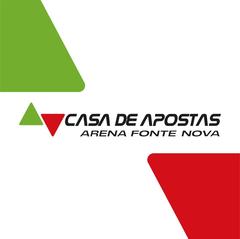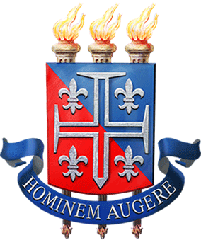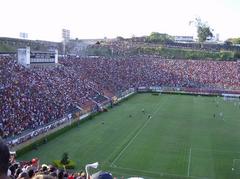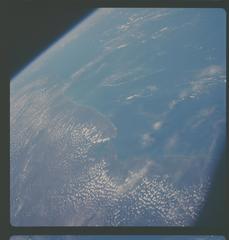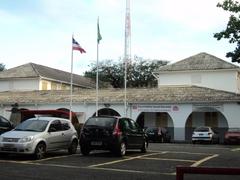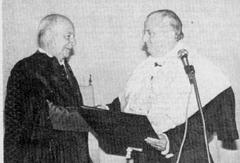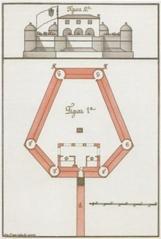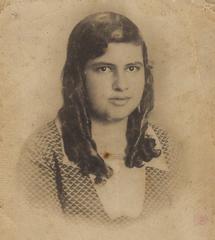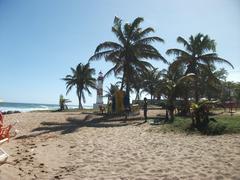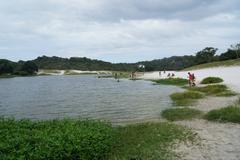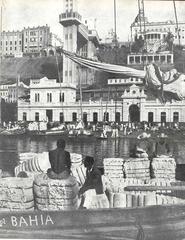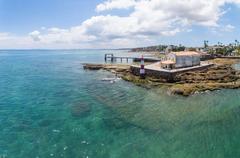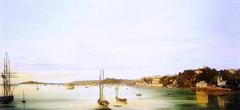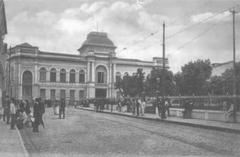
Visiting the Church of Nosso Senhor do Bonfim, Salvador, Brazil: Complete Guide to Tickets, Hours, History, and Tips
Date: 04/07/2025
Introduction
The Church of Nosso Senhor do Bonfim, perched atop the Colina Sagrada in Salvador, Bahia, is a profound symbol of Brazil’s spiritual, historical, and cultural identity. Built in the 18th century, this revered Catholic sanctuary is celebrated for its stunning Portuguese colonial architecture, vibrant festivals, and the dynamic interplay between Catholic and Afro-Brazilian traditions. Drawing thousands of pilgrims and visitors each year, the church offers a unique window into Bahia’s heritage, blending sacred devotion with lively community rituals, most notably the famous Bonfim ribbons and the Lavagem do Bonfim festival. This guide provides everything you need to know for a memorable visit, from historical context and architectural features to practical advice on tickets, hours, accessibility, and local customs.
For further details, see Adequate Travel and Salvador Guidebook.
Table of Contents
- Origins and Construction
- Religious and Cultural Significance
- The Bonfim Wish Ribbons Tradition
- The Lavagem do Bonfim Festival
- Practical Visitor Information
- Architectural Highlights
- Syncretism and Afro-Brazilian Identity
- Festivals and Community
- FAQs
- How to Get There
- Visitor Etiquette and Dress Code
- Safety, Facilities, and Nearby Attractions
- Essential Tips
- Plan Your Visit and Further Resources
Origins and Construction
Construction of the Church of Nosso Senhor do Bonfim began in 1745, funded by Portuguese nobleman Theodósio Rodrigues de Faria to honor Senhor do Bonfim—an invocation of Jesus Christ associated with hope and miracles. The church was completed in 1772, quickly establishing itself as a central place of worship and pilgrimage in Salvador (Adequate Travel).
The structure is a blend of Rococo and Neoclassical styles, evident in its symmetrical twin bell towers, grand façade, and ornate interior, which features gilded altars, intricate woodwork, and sacred art by renowned Bahian artists Franco Velasco and José Teófilo de Jesus.
Religious and Cultural Significance
The church is a spiritual heart for Salvador, symbolizing the confluence of Catholic and Afro-Brazilian religious expressions. Brought by Portuguese settlers, the devotion to Senhor do Bonfim merged with Candomblé practices, reflecting Bahia’s unique syncretic faith. The church is renowned as a center for miracles; its Sala dos Milagres houses thousands of ex-votos—handwritten notes, photos, and wax body parts—offered in gratitude for answered prayers (Salvador Guidebook).
The Bonfim Wish Ribbons Tradition
A defining practice at the church is the tying of “fitas do Bonfim”—colorful ribbons inscribed with “Lembrança do Senhor do Bonfim da Bahia.” These 47 cm ribbons, matching the length of the right arm of the Christ statue, are tied with three knots, each representing a wish. Tradition holds that when the ribbon naturally falls off, the wishes come true. While commonly worn on wrists, visitors also tie them to the church’s iron railings, creating a tapestry of hope and devotion (Salvador Guidebook).
The Lavagem do Bonfim Festival
Held every January, the Lavagem do Bonfim is one of Salvador’s most vibrant festivals, drawing over a million people for a procession and ritual cleansing. The event begins with a pilgrimage from the Church of Conceição da Praia and culminates in Baianas (women in traditional white dress) washing the church steps with scented water. This celebration beautifully unites Catholic and Candomblé traditions, symbolizing spiritual renewal and community solidarity (Adequate Travel).
Practical Visitor Information
Visiting Hours
- Monday–Saturday: 7:00 AM – 5:00 PM
- Sunday: 7:00 AM – 12:00 PM
Hours may vary on religious holidays or during festivals.
Tickets
- Entry: Free (donations appreciated)
- Ex-voto Museum: May charge a nominal fee
Accessibility
The church is wheelchair accessible with ramps at the main entrance. Some historic areas may have uneven flooring; assistance is available upon request.
Guided Tours
Guided tours can be arranged via Salvador tourism offices or local operators and are recommended for deeper historical and cultural context.
Architectural Highlights
Exterior Features
The church’s imposing façade features twin bell towers capped with bulbous domes (added in the 19th century) and is adorned with white-and-yellow Portuguese azulejo tiles, echoing Salvador’s colonial heritage (Everything Explained Today, Wikipedia).
Interior Art and Sala dos Milagres
Inside, the nave’s wooden ceiling is painted by Franco Velasco (1818–1820), depicting survivors giving thanks for salvation at sea. The sacristy and other spaces feature works by José Teófilo de Jesus. The Sala dos Milagres is filled with ex-votos—wax limbs, photos, and notes attesting to the faith and gratitude of devotees (Lonely Planet, Condé Nast Traveler).
Decorative Elements
The lower façade and select interiors are decorated with azulejo tiles, both for aesthetics and protection from the humid climate. The ironwork railings, covered in Bonfim ribbons, are an iconic sight (Lonely Planet).
Syncretism and Afro-Brazilian Identity
The church stands as a beacon of religious syncretism, where Senhor do Bonfim is identified with Oxalá, the supreme orixá in Candomblé (UNESCO, BBC Brasil). This blending is most visible during festivals and in daily worship, making the church a living testament to Bahia’s multicultural heritage.
Festivals and Community
Festa do Bonfim
This ten-day January festival features processions, the Lavagem do Bonfim, Masses, music, and street food (Bahia Turismo). The washing of the church steps by Baianas is a highlight, symbolizing both spiritual and social cleansing (Folha de S.Paulo). The festival is an exuberant affirmation of Afro-Brazilian identity and religious tolerance, attracting millions of participants annually.
Frequently Asked Questions (FAQ)
Q: What are the visiting hours for the Church of Nosso Senhor do Bonfim?
A: Monday–Saturday 7:00 AM–5:00 PM; Sunday 7:00 AM–12:00 PM.
Q: Is there an entrance fee?
A: Entry is free; donations are welcome.
Q: Are guided tours available?
A: Yes, through local tour operators or the Salvador tourism office.
Q: Is the church accessible for people with disabilities?
A: Yes, with ramps and assistance available.
Q: When is the Lavagem do Bonfim festival?
A: Annually in January.
Q: Where can I get Bonfim ribbons?
A: From vendors outside the church and during festivals.
How to Get There
Located in the Bonfim neighborhood, the church is easily reached by taxi, ride-share, or public bus from Salvador’s city center or the Pelourinho district. Travel time averages 20–30 minutes. Ample parking is available nearby. For public transit, check local bus lines serving the Bonfim area (Salvador da Bahia Official Tourism).
Visitor Etiquette and Dress Code
- Dress modestly: Cover shoulders and knees; hats off inside.
- Photography: Permitted, but avoid flash and respect worshippers.
- Bonfim ribbons: Make three wishes—one per knot—and allow the ribbon to fall off naturally for your wishes to come true. Do not cut or forcibly remove it (Wikiwand).
Safety, Facilities, and Nearby Attractions
- Safety: The area is generally safe during the day, especially around the church. Stay vigilant for pickpockets during festivals.
- Facilities: Restrooms, souvenir stalls, and water vendors are on site.
- Nearby attractions: Visit the Mercado Modelo, Pelourinho, and Lower City beaches for a broader Salvador experience (Salvador da Bahia Official Tourism).
Essential Tips
- Arrive early to avoid crowds, especially on Fridays and during festivals.
- Hydrate and wear sun protection.
- Support local vendors when purchasing ribbons or souvenirs.
- Learn basic Portuguese phrases or carry a translation app.
- Respect religious practices and ask before photographing people, especially Baianas in festival dress.
- Plan transportation in advance.
Plan Your Visit and Further Resources
For up-to-date information on hours, special events, and accessibility, consult the Salvador da Bahia Official Tourism or inquire at your hotel.
Download the Audiala app for offline access to Salvador travel guides and updates. Follow us on social media for tips and event notifications.
Summary
The Church of Nosso Senhor do Bonfim stands as a vibrant testament to Salvador’s spiritual and cultural legacy. Its architectural beauty, profound syncretic rituals, and welcoming atmosphere make it a must-visit destination for travelers and pilgrims alike. Whether attending a festival, tying a wish ribbon, or exploring its sacred art, your visit promises insight into Brazil’s rich tapestry of faith and tradition.
References
- Church of Nosso Senhor do Bonfim in Salvador: History, Traditions, Visiting Hours & Tips, 2024, Adequate Travel
- Salvador Guidebook, 2024
- Wikipedia: Church of Nosso Senhor do Bonfim, Salvador
- Everything Explained Today: Church of Nosso Senhor do Bonfim (Salvador)
- UNESCO: Historic Centre of Salvador de Bahia, Brazil
- BBC Brasil: Bonfim and Afro-Brazilian Syncretism
- Bahia Turismo: Igreja do Bonfim
- Folha de S.Paulo: Lavagem do Bonfim
- National Geographic Brasil: Fitinhas do Bonfim
- G1 Globo: Sala dos Milagres
- Prefeitura de Salvador: Igreja do Bonfim
- O Globo: Interfaith Dialogue at Bonfim
- Visit Salvador da Bahia: Igreja do Bonfim
- Wikiwand: Church of Nosso Senhor do Bonfim, Salvador
- Salvador da Bahia Official Tourism

